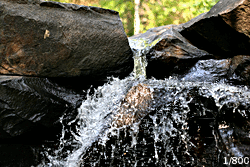 Image via Wikipedia
Image via WikipediaThat is most applicable when the background is distracting, and is taking away, instead of adding, to the subject being photographed.
Or, as in many wildlife photography cases, having the background surrounding just at the right degree of blurring boosts the subject matter being photographed, and brings the viewer's attention to the subject matter - and fixes it there!
Shutter speed

As has been mentioned, the shutter speed setting is on an inverse relation with the aperture value: a fast shutter speed mandates an open wide aperture, and a slow shutter speed allows a small aperture opening.
A silky-smooth water on a waterfall requires about 2 seconds and above for the shutter kept open.

These are not empirical values, but are guides.
What can affect the settings?
The speed of the subject being photographed, or course. An F1 race definitely requires, as I've heard, something like 1/30,000 of a second shutter speed to 'catch' the speeding car still - and usually, only the car is sharp, and all others in the frame blur.

All cameras are made equal, but some cameras are more equal than others.
So which one is your camera-mate?
![Reblog this post [with Zemanta]](http://img.zemanta.com/reblog_e.png?x-id=1672fec9-df1f-49c8-96b3-80a51d7d00a5)
No comments:
Post a Comment